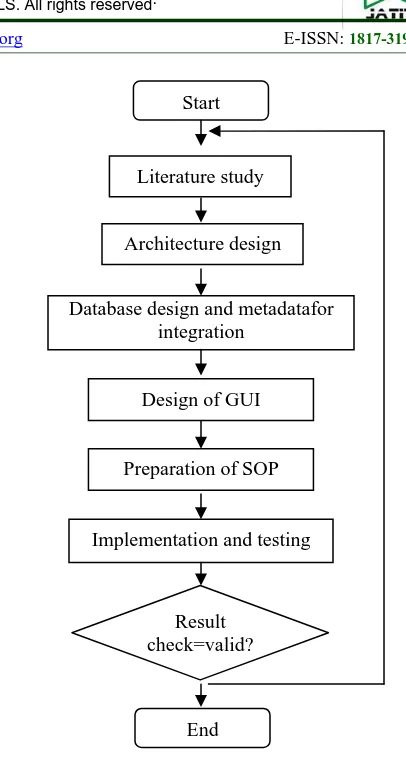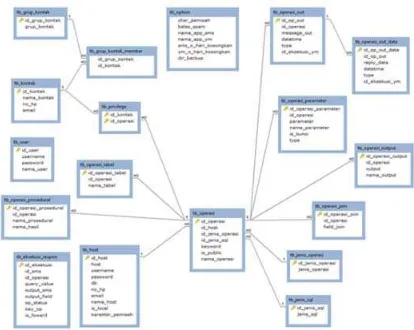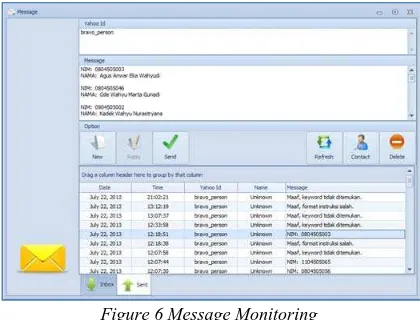Journal of Theoretical and Applied Information Technology 20th February 2014. Vol. 60 No.2
© 2005 - 2014 JATIT & LLS. All rights reserved.
ISSN: 1992-8645 www.jatit.org E-ISSN: 1817-3195
417
DATA EXCHANGE BETWEEN INFORMATION SYSTEM
AT LOW BANDWIDTH QUALITY USING MESSAGING
1
I MADE SUKARSA, 2Ni WAYAN WISSWANI, 2PUTU WIRABUANA
13
Department of Information Technology, Udayana University, Indonesia
2
Department of Informatic Management, Bali State Polytechnic, Indonesia
E-mail: 1e_arsa@yahoo.com, 2wisswani@yahoo.com,3wbhuana@yahoo.com
ABSTRACT
Data exchange is a routine activity in a distributed system. This activity can be done between organizations with equal positions or between branches and the head office. Technology commonly used as middleware is web service.In a growing organization, the effort is quite high because it requires an inter or intranet service with a good quality bandwidth and dedicated serveras a service provider. Therefore, the development of messaging-based middleware can be used as a cheap alternative. The first year study is focused to produce a middleware prototype that can work on a DBMS engine, that is homogenous DBMS MySQL. In the second year, prototypes that can work in heterogeneous DBMS engine will be developed. The first year prototype result can be used to exchange data between applications by utilizing meta data for each homogeneous DBMS.
Keywords: Data Integration, Messaging, Low Bandwidth, Distributed System, Data Exchange
1. BACKGROUND
When an organization began to grow,new branches are spreaded in different geographical areas.The organization began to exchange data and information between branchesin the context of real-time, near real-time or offline mode (batch processing). Data exchange for various operation and management needs, such as circulation control of goods between branches, inter-branch withdrawal, and sending sales report from branches to head office. The information obtained through various channels such as telephone, email, courier delivery,and middleware applications.
Recent middleware technology that has been widely used for exchange data is web services. Web service is a service that is built on a server that provide data exchange between applications. When applications are geographically dispersed, it takes a public IP and a reliable internet connection so that communication between various nodes and web service applications work well. Web service development, integration with applications, IP purchase and provision of bandwidth services are expensive.
In the growing company,as a groupof micro or small financial institutions,the funds allocated for IT spending are ussually not enough to meet the cost. Most are still focused on the application development to support branch
operations and some new improvement about application integration between branches. It is revealed from a preliminary study conducted at a financial institution.
This institution has several business unit ssuch as workshops, online electrical checkouts, savings and loan business,and development plans, which are located at few mini markets scattered in several areas. Management also intends to provide savings and loan services in some areas by leveraging existing business office in a few places, but is hampered in terms of data integration between headquarters and branch offices. Management's current operational difficulties is to control activities in real time. This same thing will also happened to the other growing institutions. Therefore, it is necessary to develop alternative low-cost middleware in both phases of development and operation.
vehicle message/data to be exchanged between applications from various places.
2. THEORITICAL BACKGROUND
2.1 System Integration
Information integration is the process of bringing together information using the data displayed through a single interface to see all the data of anorganization. The purpose of information integration is to display data to the user using single interface from variuos data sources. Integration is one of the solutions for an organization in order to compete in the information age because the information available is over whelming not only within the organization but also from outside organization. Integration of information can reduce data management costs because the complete information that is fast and easy to obtain,actually, is already available. Separated application in the absence of centralized integration cause complicated distribution of data and information for the organization.Integration will be able to overcome the data duplication a one to another location so that the resulting data will be consistent[6].
2.2 Message Oriented Middleware (MOM)
Message Oriented Middleware(MOM) is aflexible system mechanismto exchange data between applications in different platforms[2]. In case of integrating data, it can be done by making changes to their associated systems. This will spend more time and be expensive. MOM implementation into without making changes to the systems that will be integrated becomes a solution. [3]. Although MOM has a number of benefits, MOM also has some disadvantages. In terms of the speed of message delivery, the MOM could spend many minutes. Another disadvantage,the messages sent can not be as curtained tobe read and there is no certainty in delivery time of the message. It is depends on the receiver of the message
2.3 Database Management System (DBMS)
Database Management System (DBMS) is an application used to manage large amounts of data, consisting of the storage, editing,and data retrieval. Utilization of DBMS engine can improve efficiency, scalability, and robustness. DBMS also allows simultaneously access by several users at once[8].
2.4 Metadata
Metadata is structured information that describes and explains the information in order to make the information easy to find again, used,or maintained. Metadata is often called data about data or information about information. Metadata contains information about the contents of a file [7]. If the data is in the form of text, metadata is usually a description of the field name, field length, and field type. For the image data, metadata contains information about who took it, when was it shoot, and camera settings at the current time. If the type is a collection of files, metadata is the file names, file types, and the name of the administrator of the files
2.5 Related Research
Distributed system is a computer network system that the components of the system such as a database engine, the application,and the data are physically separated by location of branch offices[12].Therefore, it isnecessary to develop a model for exchanging data between applications. Models are commonly implemented by building a middleware for interaction and communication between different applications through APIs(Apptication Programming Interfaces) [1].
Recent efforts for exchanging data is done by building a web service. Utilization of web service for the benefit of data integration has been carried out [5] to propose amodel of integration of web-based business data service. In Indonesia,this effort was also made by the Higher Education in the database development project[11].Implementation of web service requires a public IP and the availability of high bandwidth that can not be financed by small organization.
As an alternative, had developed a model-based architecture for data exchange messaging or better known as MOM(Message Oriented Middleware) as a middleware that enables communication via messages. MOM provides variety capabilities in sending a message, including point-to-point messaging model and publish-subscribe, message filtering, transactional messaging, and message delivery once-and-once-only. In general, the MOM serviceis similar to the postal service, the message was delivered to the post office and the postal service will then have the responsibility to make the process of sending secure messagesto the destination(Edward C, 2004).
Journal of Theoretical and Applied Information Technology 20th February 2014. Vol. 60 No.2
© 2005 - 2014 JATIT & LLS. All rights reserved.
ISSN: 1992-8645 www.jatit.org E-ISSN: 1817-3195
419 this application, users can input, edit,and delete data on the server by using SMS. Another technology used is Yahoo Massenger for purchasing prepaid phone credit[13]. Recent research conducted by Sukarsa[10]), which makes MOM design that can be implemented in social media is Yahoo Messenger. This study is a continuation and an evaluation of existing design to be developed into a prototype with additional capabilities to exchange data between applications and business process integration.
3. SYSTEM OVERVIEW
3.1 RESEARCH METODOLOGY
There are a few steps that will be implemented in this research. These steps will be described in detail, as follows: 1. Literature study
This study was conducted to understand the messaging programming techniques , the study of hardware and programming language to be used
2 Preparation of design
The design of the model will include several subactivities, which are:
- The design of the system architecture - Design database using data normalization
techniques and ERD(Entity Relationship Diagram)
- Designing metadata to handle data integration between applications with homogeneous DBMS platform
- Design of the Graphical User Interface (GUI) for messaging applications to exchange data
- Preparation of SOP ( Standard Operating Procedure ) for the implementation of the system
3. Implementation of the model
Implementation of the model performed on a desktop based application design model that has been created
4.Testing and preparation of the final report Testing is done to ensure whether the model has been implemented to provide correct results and the results compiled in the final report of the
work .
Overall phase of the study may be presented in the flowchart in Figure 1 .
Figure 1 Research Flowchart
3.2 System Overview
System architecture that developed in this researchis by building a messaging-based middleware (MOM) as an interpreter between the existing systems that already existas shown in Figure2. MOM is designed to have a connection to the MOM database and external databases. MOM database contains metadata for a business process to exchange data between applications. External database is a database that is used by the existing system. MOM will treat external database as a source for exchanging data to another applications through theMOM embedded in other systems.
Start
Design of GUI Literature study
Architecture design
Database design and metadatafor integration
Preparation of SOP
Implementation and testing
Result check=valid?
4. DATABASE DESIGN AND USER INTERFACE
4.1 Database Design
This section describes the results of a database design using normalization techniques. The resulting design can store metadata associated with existing systems so that dinamically open the oportunity to be applied in various cases without changes to the programming level. Changes can be done at configuration level
Figure 3 Database Relationship
Here is an explanation of each table in figure 3 :
1. tb_eksekusi_respon : used to store queued data of YM execution operation in this application
2. tb_grup_kontak : used to store data for a group of contacts in this application
3. tb_grup_kontak_member: to store data for contact group members in this application. 4. tb_host : to store the data host/server that will
be the source of the data from the application to beexchanged
5. tb_inbox_ym : to store data into the message that is sent by an application prototype client 6. tb_jenis_operasi : to store the types of
operations that are served by the server prototype
7. tb_sql : to store the types of operations that are served by the server prototype
8. tb_operasi to store a variety of database operations that can be performed on this prototype
9. tb_operasi_join to store a variety of database operations that can be performed on this prototype that requires a join operation between tables
10. tb_operasi_out database for storing the various operations that can be performed remotely 11. tb_operasi_out_data to store the results of
operations performed remotely in the form of groups of data
12. Tabel tb_operasi_output to store the non-remote operating results in the form of groups of data
13. Tabel tb_operasi_parameter to store various parameters that are used in the data exchange 14. Tabel tb_operasi_prosedural to save various
database operations performed by executing aprocedure
15. tb_operasi_tabel contains the metadataof the tables as source of database operations
16. tb_option to store application configuration 17. tb_privilege to store theprivilege (access
rights) of each user listed as contacts in this prototype
18. tb_sent_ym to store messages/data that have been sent to there questing client service 19. tb_user to store user data
4.2 User Interface Design
This section will explain some important menu contained on this prototype.
4.2.1 Main Menu
Main menu in figure 4 is the start menu that provides navigation to access the various functions within the application. General menu
Figur 2 System Overview
Sistem A
Sistem B
Sistem C
MOM MOM
MOM DB
A
DB MOM
DB MOM
DB B
DB MOM DB
Journal of Theoretical and Applied Information Technology 20th February 2014. Vol. 60 No.2
© 2005 - 2014 JATIT & LLS. All rights reserved.
ISSN: 1992-8645 www.jatit.org E-ISSN: 1817-3195
421 contains menus for managing user, profile, database configuration, and command separator character
Figure 4 Main Menu
4.2.2 Database Configuration for MOM
Database Configuration for MOM in figure 5 is used for setting up the connection to the MOM database server consists of an IP address, database name, user name, and password. MOM database is a database that contains all the metadata of the application to be exchanged
Figure 5 Database Configuration for MOM
4.2.3 Message Monitoring
Menu in Figure 6 is used to monitor the message traffic in and out to know the success level of the prototype
Figure 6 Message Monitoring
4.2.4 Database Configuration for Application Menu in Figure 7 is used for setting up a connection for various database applications whose
data will be exchanged. This prototype can serve more than one connection to the database
Figure 7 Database Configuration for Appication
4.2.5Service at Client
Menu in Figure 8 is the display of data processing required by a client to the prototype. Based on incoming requests, the prototype will be responding by executing the service that have loged in into prototype server.
Figure 8 Service at Client
5. CONCLUSION
With MOM-based prototype architectural design, data exchange between applications can be done at low-quality bandwidthwith out requiring public IP that occurs in the web service based platform.
REFRENCES :
[1] Bernstein,P.A., 1996, “Middleware: a model for distributed system services”, Communications of the ACM, pages 86-98
[2] Curry Edward, 2006, “Increasing MOM Flexibility with Portable Rule Bases”, IEEE CS Press
[3] Curry Edward, 2004, “Message-Oriented Middleware". In Middleware for Communications, ed. Qusay H Mahmoud, 1-28 (chapter 1), John Willey and Sons
[4] EikoYoneki, 2003, “Mobile Applications with a Middleware System in Publish-Subscribe Paradigm”, University of Cambridge Computer Laboratory
[5] Hansen.M., dkk 2002, “Data Integration using WebServices”,
web.mit.edu/smadnick/www/wp/2002-14.pdf [6] Manouvrier,B., and Menard, L,2010,
“Application Integration”, John Willey and Sons
[7] Ponniah, P., 2010, “Data Warehousing Fundamentals for IT Professionals”, John Willey andSons
[8] Ramakrishnan, R and Gehrke,J., 2003, “Database Management System”, McGraw-Hill
[9] I Made Sukarsa, 2011, “Rancang Bangun Web Iklan Berbasis Mobile”, Jurnal Lontar Komputer Volume Juni 2011
[10] I Made Sukarsa, 2012, “Design of Message-Oriented Middleware Based on Social Messenger”, IJCSET Vol 2, Issue 4, page 1129-1134
[11] Tim PDPT Dikti, 2010, Pengenalan Web Service,
pdpt.dikti.go.id/materi/Sesi_II_Pengenalan_W ebService.pdf,2010
[12] Nunn, R., “Distributed software architectures
using middleware”, http://www.cs.ucl.ac.uk/stafFW.Emmerich/lec
tures/3C05-02-03/aswel 8-essay.pdf


